A small explosion
This week: Michaelmas flowers; Forest ride; Completely stumped; A bit of a goitre; A small explosion; Garden work;

As I mentioned last week, I went over to Split on Wednesday, with the purpose of getting the correct joining strips for my polytunnel roofing sheets.
I was in “pole position” at the port to catch the 14:30 ferry home, with the car laden as usual. I’d made the best of the trip, coming back with everything which was on my shopping list.

Bright and early on Thursday, I started to assemble the sheets. Yes the replacement joint strips are the correct 6mm, but no, I still cannot get the 2 m² sheets to fit together on the roof.
Working at height is OK, but with an arm length of 60cm, I cannot even reach half way along an individual sheet.
The tightness of the strip will certainly keep moisture out, but unless I can find a way to slide the plastic sheets into the joint strip, I am going to have to find another method of roof construction!

I have given up for this week and will do more research, plus some trial and error on the ground to see how I can fix the roof on the polytunnel. I can see why people use polythene sheeting – it’s easy!
Weatherwise, it has been another hot and sunny week. I’ve seen several neighbours this week and they are all lamenting the poor olive harvest.
No one will have any spare oil to sell because the fruits are small and shrivelled.

Some crops are just not worth the effort to pick and will be left to fall off and rot.
There is still no sign of any substantial autumn rain and we are already at a deficit of 250 mm for this point in the autumnal rainfall cycle.
Michaelmas flowers
There is always something new to learn; every day’s a school day!
This week while I was thinking about writing about some garden Michaelmas Daisies for the blog, I realised that what I thought were Michaelmas Daises are in fact small-flowered Chrysanthemum.
Whatever, they look brilliant at the moment in the warm autumn sunshine.
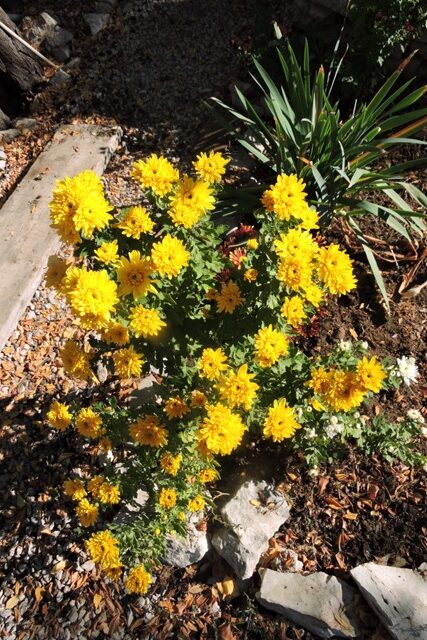

These are what are called Quilled Bloom Chrysanthimum.
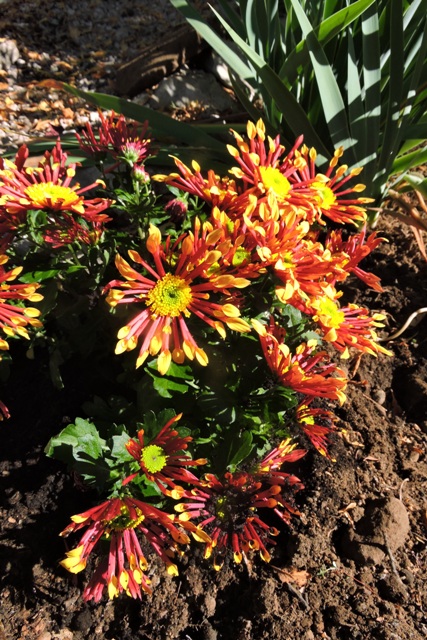
I had always thought that Chrysanthemum were some of the most difficult flowers to grow, so have never consciously attempted them.
When I lived in the UK, I had Michaelmas Daisies, Aster amellus, in the garden, however that was a long time ago.
A couple of years back when I saw some flowers for sale in the supermarket which I thought were Michaelmas Daisies, I bought them and planted them in the orchard border. They are the thriving plants you see above.
At the time I didn’t look for or at the label. Now having identified them properly, perhaps I should look for some Michaelmas Daisies as well…
We are approaching “Halloween” on the 31st October, All Hallows Eve, and All Saint’s Day on 1st November, a Public Holiday.
This is followed by ‘Dusni Dan’, All Soul’s Day on 2nd November. This is the time of year when families flock to the graveyards to tidy up and to place flowers and candles on the graves of relatives.
Everywhere there are flowers for sale, exclusively Chrysanthemum, in four primary colours; yellow, white, pink and chocolate brown.

In Europe, the chrysanthemum is strongly associated with death and it is a terrible social ‘faux pas’ to offer the plant or flowers on any other occasion.
They are commonly used in funerals, and are also considered a symbol of immortality, as the plant can survive through the winter frost and needs little care.
It wasn’t until the 17th century that the flower was introduced from Japan to the Western world where its symbolism took a more foreboding turn.
Chrysanthemums were often placed on gravestones in Europe and became associated with death because they are always in flower in the autumn, at the time that All Saint’s and All Soul’s days are celebrated.
I rather like my small flowered variety, because they only grow to 50 cm tall, so don’t need staking and they provide lovely primary colours in the late autumn
Forest ride
I have been making the best of the wonderful weather, with regular walks through the Maquis and along the forest rides.
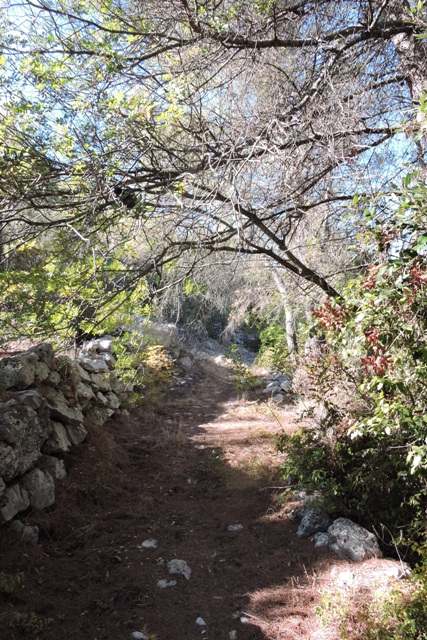
There is little sign of any wild flowers, but then they are waiting for some autumn rain, just as everyone is.
One thing I did notice this week which have started to grow are the winter Lichens.

Lichens are an overlooked plant group that can be found in different forms on every continent. Here there are two main types to be found along the paths. Both silver grey, but one with flat leaves and the other made up of springy strands, like a sponge.
Both are in this photograph. In the centre the delicate fronds that look like sea weed, whilst on the edges, the mesh which is reminiscent of coral.
Elsewhere the acorns of the evergreen Home Oak are beginning to ripen and fall.

I’ve seen several places where the Wild Boar have been rooting for grubs. I remember that in the UK and other countries, pigs are turned out into oak forests to feed on Acorns, but it seems here that the wild pigs do not bother with them.
Back in the early summer (blog 20) I remarked on a thorny climber I had found alongside one of the paths. This week it is in flower.
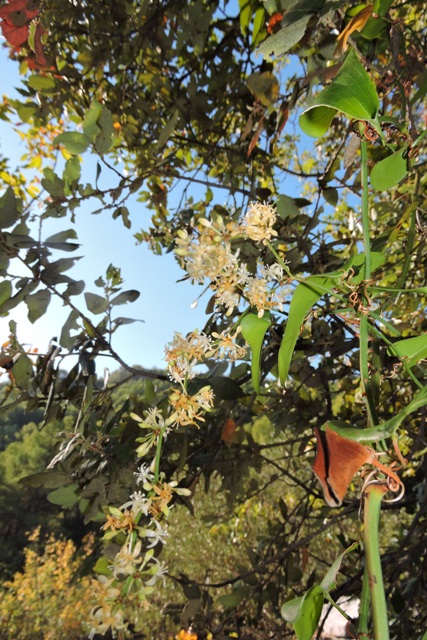
I was eventually able to positively identify it as Smilax aspera, and have been waiting for some flowers to appear. Now I will have another wait until the cherry red berries ripen in late winter.
While all this is happening around my home, in the garden I have my Manuka or New Zealand tea tree, Leptospermum scoparium, flowering. The sweet scented blooms are very attractive to bees and moths at this time of year.
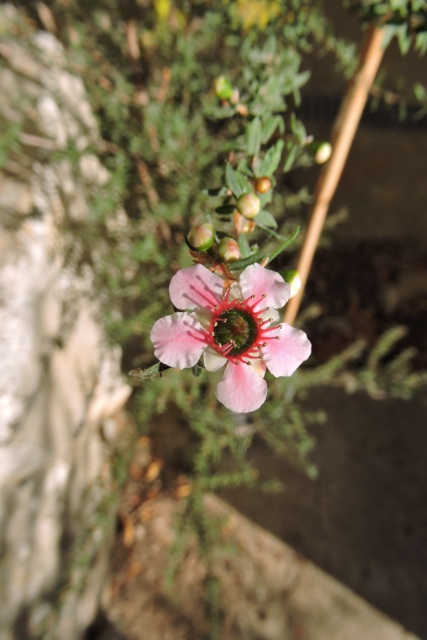
Completely stumped
I have two large stumps which need removing in the citrus orchard.
One is a Pomegranate tree, called Šipac (pronounced ‘she¬pack’), the other my old Mandarin which has died.
Šipac are rather badly behaved children. They are deep rooted and readily produce suckers from around the base of the tree and from pieces of root. The wood is brittle and splits readily.
Once a trunk has reached around 10 cm in circumference, it will die and one of the many suckers will replace it.
This means that a Šipac tree will grow into a clumping mass of around 3.5 meters tall with a lot of suckers giving it a girth of up to two meters.
Add to that that each stem has thorns all along its length and the tree is not people friendly.
The fruits are nice, but even then they are difficult to open to get at the kernels inside. The tree also takes water and nutrients from everything growing nearby.
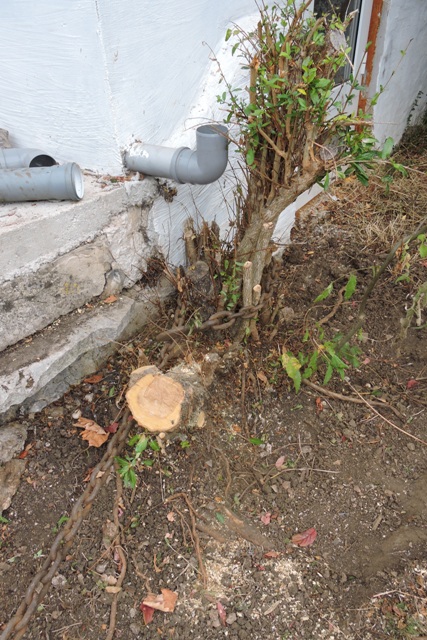
So when I have one growing tightly against the wall of the cottage and gently spreading outwards, you will understand why I need to remove it.
Apart from filling the gutters with leaves in the autumn, I have other Šipac trees elsewhere, so this is one I don’t need.
I started by digging round the bowl of the tree after cutting back the thorny new growth. That will all be shredded later.
However there are a lot of thick, 5 cm diameter roots. Although the soil is as dry as dust, even with a pickaxe, I made little impression. because of the tangle of roots.
I’ve boxed myself into a corner here because I cannot get the mini digger into the orchard to try and do some of the hard manual work.
My plan was to use my two tonne hand winch and some chain to pull it out, but I quickly realised I have nothing remotely strong enough to anchor the winch to, to enable me to pull it from the ground.
I was reminded though of the now banned Australian TV advert for Toyota Hilux pickups, which seem especially good at removing tree stumps!
A bit of a goitre
There is a medical problem of the Thyroid glands called Goitre, which causes a swelling around a person’s throat.
At first glance my old Mandarin seems to have one at soil level around the base of the tree. It has been like this since I bought the property.
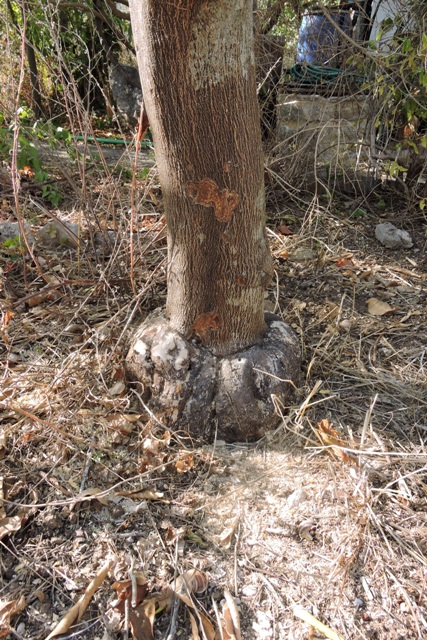
Up until we had the big freeze in January 2017, which killed all my Citrus, this tree was always laden with fruit. The tree lost all its leaves, but seemed to recover.
However ever since, it has been slowly dying back from the tips of the branches. This year it has died completely.
Technically this tree growth is called a “Burl”, and is the result of the tree being under stress at some point, perhaps through an injury or after a viral infection.
Burls are not a disease, more the tree’s response to some kind of external stimulus.
Burls are greatly prized my woodworkers because of their intricate internal patterns, designs and colours.
As I dug down, what became apparent was that the burl extended quite a way below the soil level.

I was using the pickaxe again and kept coming up against some very thick roots, but also roots which were rotten and dead.
The normal productive lifespan of a citrus tree is 50 to 60 years.
What I would like to do is to complete a ring count, once I have the tree out, to see exactly how old it is.
I would also like to save the burl and make something out of it, but I also need to make sure that the wood seasons slowly, so it doesn’t crack as it dries. This set me off on another internet search.
There are of course chemicals to dry wood, but also it seems a salt and water paste applied to cut surfaces works. All that is OK, but I need to get the stump out first.
I found the underground irrigation pipe, before I put a fork through it, then excavated around the base of the tree.
With the main root bowl exposed I attached my chains and hand winch to the thickest part of the tree.
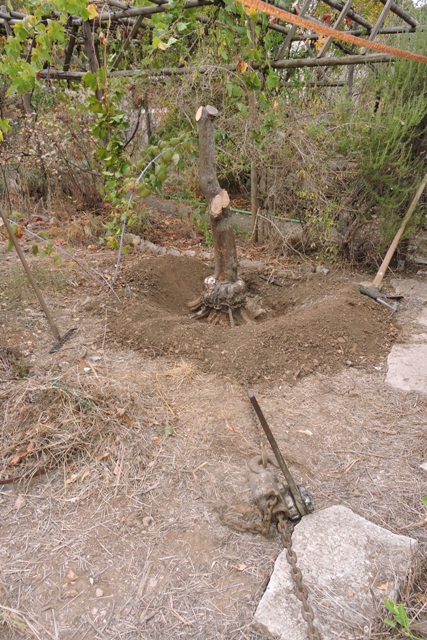
This is a very old British made winch with a capacity of 2½ Imperial tons. I tightened and tightened but nothing was moving. My concern was that one of my chains, whose capacity I do not know would break, so I loosened the chains.
Moving the attachment point up the trunk to get more leverage, I tried again and there was some ominous cracking, but still not much movement.
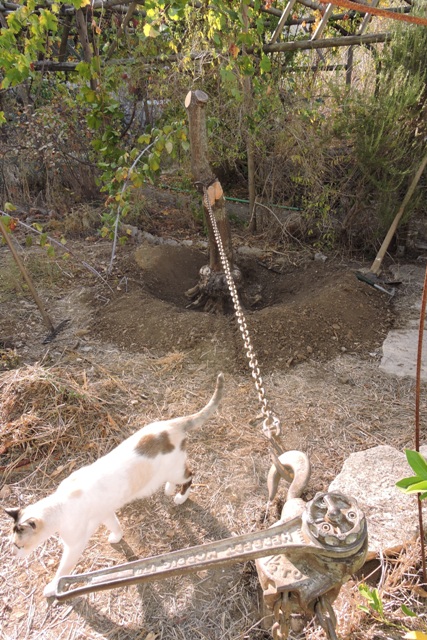
Loosening everything I exposed more roots and cut the thickets with the chain saw, then attached the chain to the top of the trunk.
There was more cracking and I was able to get the tree stump out of the hole.
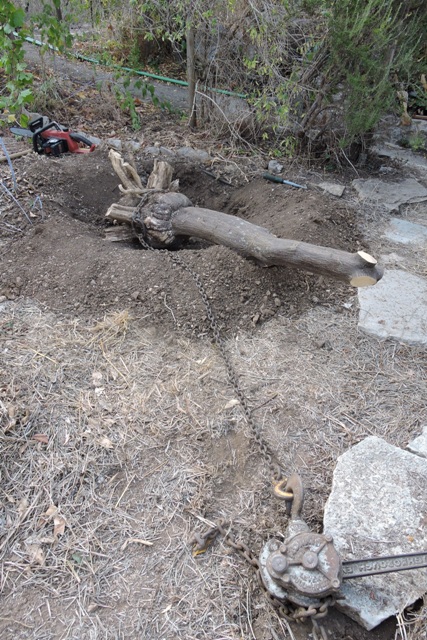
Examining the stump, almost all the roots have died, with just a couple of small areas of live tissue. The final task was again with the chain saw, to cut everything into a manageable size.
I still intend to try and salvage the Burl and count the annual rings.


Just a small explosion
About lunch time on Thursday I walked into the kitchen and was surprised to see a spreading pool of red liquid on the floor. It was coming from the fridge.
My kitchen is of the ‘compact’ variety and so the appliances are likewise.
I have a small fridge under one counter, where I keep the everyday things, a few eggs, milk, cheese, mayonaise, butter etc.
In the utility room I have my full size fridge along with a chest freezer.
So the fridge in the kitchen tends to have things which get used regularly and quickly.
A couple of weeks ago one of my neighbours gave me a plastic bottle of wine, which went into the door pocket, along with some sparkling water.
I hadn’t thought much more about it, until Thursday that is.
The fridge door was open and I saw that the plastic bottle had exploded, split from top to bottom.
The inside of the fridge and all its contents had been liberally coated in red wine and everything was running onto the floor.

I didn’t actually hear the bang, and fortunately I don’t think any of the felines were inside at the time either.
So then began the clear-up. Well it was about time for an autumn clean!
First job was to mop the floor. I am concerned that the grout in between the tiles will have been coloured by the tannins in the wine and at some point I may need to dig it out and replace it.
With the floor cleaned I started on the fridge.
All the trays and boxes went into the dishwasher. Red wine is a rather sticky substance and gets into every crevice, so I started by dismantling the light unit and the door switch.
Some time and a lot of hot water later it was looking respectable again. I lost some eggs and some plastic containers, fractured by the force of the explosion, but most of the fridge conents were salvagaeable.
As to why it happened, my neighbour thinks that because it was new wine, even in the 4ºC temperature in the fridge, there was still some fermentation taking place.
Eventually the plastic bottle was unable to resist the pressure inside and failed.
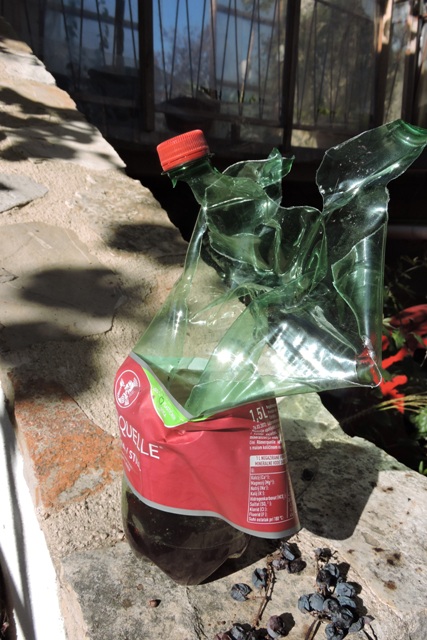
I will be careful in future with bottles of wine!
It did remind me of a similar experience I had with home made Ginger Beer.
The same applies to bottles of ginger beer, which can also continue to ferment and explode with the same consequences, as I have found out to my cost. Lesson learned!
Garden work
I’m pleased to say that I’ve made progress in the Citrus orchard this week.
Around several of my citrus trees, I have replaced the weed suppressant matting and the mulch from my mulching machine. I also added a new irrigation line and adjusted the emitters.

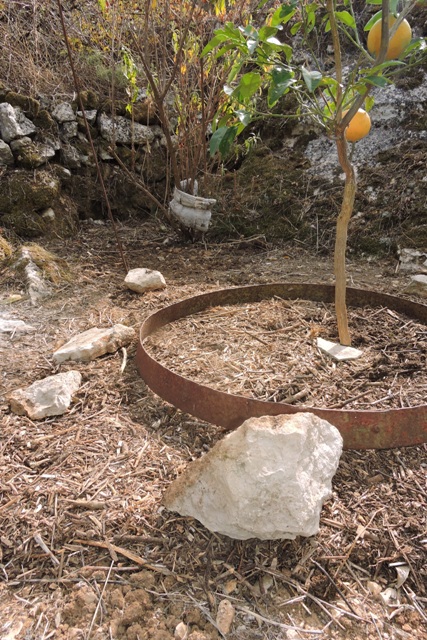
This is a Grapefruit, but all the trees in the orchard have some degree of matting and mulch.
With several trees protected, I have started using the plant waste which came in the truck a couple of weeks ago and have laid around a quarter so far.

The plant mulch is around 30cm deep and I really hope it will improve the soil and prevent wed growth.
It is almost 6pm and the sun has just set. Tomorrow morning the clocks in Europe will go back by one hour ending “summer time”. So tomorrow it will be getting dark by 5pm.
I really don’t like dark winter mornings and afternoon sunsets. NCG
4 Responses
Andy Robinson
Serves you right Norman….you should have drunk the wine instead of hoarding it!
Mike creed
Hi Norman
Alway enjoybreading your on-going pursuits.
Keep it up
Alan Wheeler
Hi Norman
Drink more wine. Regarding the attachment strips: have you tried using the liquid used to lubricate electric cables being drawn thru PVC pipes? I used it when wiring my outdoor trains and it made the 30 foot “pulls” much easier. And it doesn’t “foam up” like dish soap if it gets wet.
Michael
It’s never a good idea to bottle wine under a tight cap before secondary fermentation is complete!